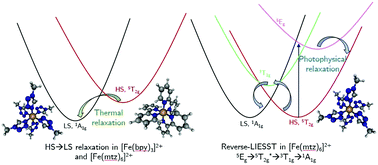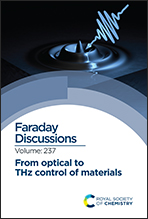Quantum dynamics simulations of the thermal and light-induced high-spin to low-spin relaxation in Fe(bpy)3 and Fe(mtz)6†
Abstract
First row transition metal complexes with d4 to d7 electronic configurations exhibit spin-crossover (SCO), which can be induced by external stimuli, such as temperature, pressure and light. The low-spin to high-spin transition has been widely studied, but very little is known about the reverse process. Here, we present a theoretical study of thermal and light-induced high-to-low spin crossover in prototypical Fe(II) complexes. The lifetime of the high-spin state in the thermal process is determined using Fermi’s golden rule. With this methodology, we have accurately computed the transfer rate of the HS state thermal relaxation at several time scales (from sub-nanosecond to a few seconds) in two different iron complexes. The use of quasi-degenerate perturbation theory (QDPT2) in the analysis of the LS–HS spin–orbit coupling has allowed us to identify 3T1 as the main intermediate state coupling the LS and HS states. The light-induced process has been studied using wavepacket quantum dynamics along the main vibrational coordinates (one symmetric and two asymmetric Fe–N stretchings). The study suggests that after the initial excitation from the 5T2g to the 5Eg state, the population is transferred back to a vibrationally hot 5T2g state, from which a small amount of the population is transferred to the 1A1g state via the intermediate 3T1g. Most of the population remains trapped in the HS state at the time scale of the simulation.

- This article is part of the themed collection: From optical to THz control of materials


 Please wait while we load your content...
Please wait while we load your content...